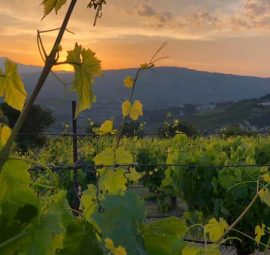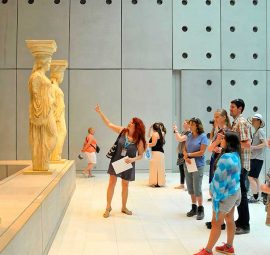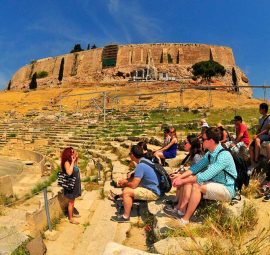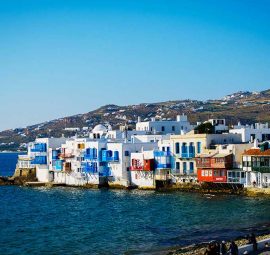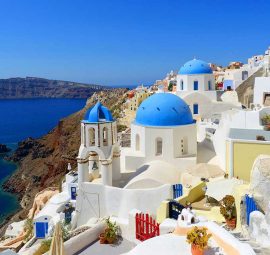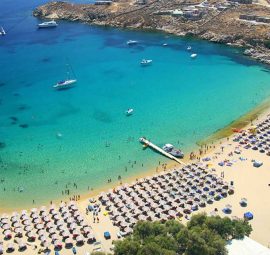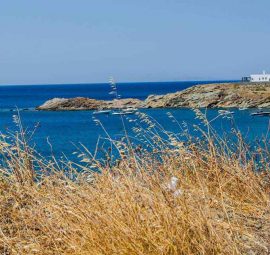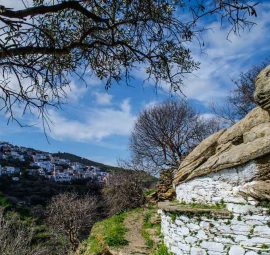HightLights
- Acropolis: Few sights in the world compare to Athens Acropolis. Rising above the concrete jungle of modern Athens, the Acropolis (literally “high city”) stands proudly as a symbol of the city’s former glory. The ancient city of Athens began on the top of this hill, as it was a perfect defensive location surrounded by a ring of mountains. Walking up the hill you will find yourself among ancient masterpieces of classical Greek architecture.On your way up you will pass by the ancient theater of Herodeion, built between 160AD – 174AD by the wealthy benefactor of Athens, Herodes Atticus as an ode to his late wife Rigilla. Herodeion re-opened 60 years ago and its excellent acoustics has attracted some of the world’s best performers to appear on its majestic stage, including Nana Mouskouri, Luciano Pavarotti and Frank Sinatra to mention a few. Attending a summer performance there is a majestic experience you will not regret. On the top of the hill you will find a group of architectural masterpieces from the Ancient Greek period, dating back to the fifth century BC. Most famous of all is the Parthenon, a temple dedicated to God Athena, goddess of wisdom and protector of Athens. Parthenon is considered to be classical architecture’s most influential building and the very symbol of Democracy itself. Here you will also enjoy a panoramic view of Athens, from Parnes Mountain all the way to Saronicos Gulf. On your way down you will also come across the Theater of Dionysus Eleythereus, the world’s first theater, dedicated to Dionysus the god of theater and wine.A visit to Acropolis will get you in the right mood to appreciate the inimitable beauty of Athens and its long rich history. It is a definite must–do and a once in a lifetime experience. But even if you are paying a short visit and you don’t have enough time to go up the hill, Acropolis will find you. It will gracefully reveal itself as you walk by the narrow streets of Downtown Plaka, while you are having a coffee in Thiseio or while you are enjoying your refreshing cocktails on the atmospheric terraces of Athens (360 bar, A for Athens, City Zen etc) . It is still the highest point in the city and the most breathtaking spectacle of the Greek capital, day and night.
- Plaka: On the slopes of Acropolis you will find Plaka, Athens older residential neighborhood. Strolling though its narrow streets you will find neo classical mansions, ancient ruins, small churches and white washes houses that will make you feel you are in a Cycladic island village. This beautiful, historical neighborhood is mainly residential and no cars are allowed. On its popular streets you will find many shops, cafes, bars and restaurants were you can sit and enjoy the quaint village atmosphere, but also some nice live Greek music shows in small local tavernas (Anafiotika district). Plaka is a refreshing old-fashion oasis right in the middle of the gigantic Athenian capital.
- Ancient Agora & Monastiraki Area: Agoras (market, gathering place) in Ancient Greece used to be open areas were people assemble for all sort of purposes, from athletic to spiritual, to political, to commercial ones. Ancient Agora is the most well-known of its kind, as it was the center of Athenian democracy where important assemblies for political and judicial functions took place. It was here were Socrates, Plato, Diogenes and Periclesspend a lot of their time, lecturing, addressing the public and questioning the Athenians on their understandings on life’s most important aspects. This peaceful space offers a great walk around scattered ruins and greenery. It is rather quiet compared to Parthenon and provides a wonderful opportunity to relax after visiting the busy ancient monuments in Acropolis.Ancient Agora is located in the Monastiraki district, right next to Plaka. Highlights include, Hephaestus Temple and the Stoa of Attalos.
- Lycabettus Hill: The famous Lycabettus Hill is located near Kolonaki area. It stands 277 meters above sea level and offers its visitors a stunning 360 view of the city, with Acropolis standing imposingly just a breath away. On the very top of the hill right below the observatory there is also a luxury restaurant. A visit on Lycabettus is highly recommended, especially around sunset time.
- Museums: Athens has an extensive list of interesting museums that hold some of the world’s most precious collections. In Athens you will be able to enjoy not only Archaic and Classical masterpieces, but also impressive private collections of wealthy Greeks showcased in stunning neo-classical mansions. The new Acropolis Museumis rated as one the best museums in the world. This modern museum is located right next to the Acropolis metro station and is devoted to the Parthenon and its surrounding temples.The National Archaeological Museum is also considered of the world’s best museums for ancient Greek art. Its collections will travel you from the 6000 B.C. right to the Roman conquest. Other well known museums include, the Benaki Museum, the Museum of Cycladic Art, the Byzantine and Christian Museum and the Athens War Museum.
- Poseidon Temple in Sounion: Approximately 70 km from the center of Athens, in the area of Sounio, you will find the famous Poseidon temple, one of the major monuments of the Golden Age of Athens. As its name reveals, it was dedicated to the god of the sea, Poseidon. This imposing temple was built on the 5TH century B.C., on the edge of a cliff overlooking the Aegean Sea. If you have time while in Athens, a visit to Sounio is highly recommended. The temple offers breathtaking Aegean views and is considered to be one of the greatest sunset spots in the whole Attica district. Right above the temple lays a serene organized beach with golden sand and green blue waters, where you can enjoy a refreshing swim on a hot summer day. On the beach you will also find a few picturesque taverns where you will be able enjoy delicious fish, mouthwatering local delicacies and also a unique view of the ancient Temple.
- Stavros Niarchos Foundation Cultural Centre (SNFCC): The Stavros Niarchos Foundation Cultural Centre in Kallithea is a world-class cultural, educational and recreational urban complex that includes new facilities for the National Library of Greece and the Greek National Opera, located within the Stavros Niarchos Park. In November 2016, the SNFCC achieved the highest and most stringent international standard for sustainable design and construction - the Platinum LEED awarded by the U.S. Green Building Council (USGBC) – for its innovative architecture and green technology.Only a short distance from the coast, it stands close to the Athens’ ancient port of Phalerum (ie. Faliro - today) and is of national importance as this vast structure has been incorporated into a new 210,000m² park and emerges from the ground as, in its architect’s words, “a dislodged piece of the earth’s crust” with the slope of its roof rising from ground level to a summit higher than 35m at the other end. The facilities are ideal for practicing sports, participating in Sports & Wellness programs or taking free use of outdoor gym and games area which hosts basketball, football, tennis and other sports. Around the SNFCC there is a 2.5km bike lane, while the SNFCC Canal accommodates kayaks and sailboats.
- Day Cruises from Athens: One of the beauties of Athens is that is very close to many magical islands. If you are visiting the Greek capital, make sure you spend a day away from the mass city sightseeing and grasp the unique opportunity to sail into the Mediterranean Sea, bathe under the warm Greek sun and swim in secluded waters.Greece’s Saronic Islands (or Argo-Saronic Islands), sit just off the mainland and Peloponnese peninsula in the Aegean's Saronic Gulf. Known for their beaches and ancient ruins, they’re popular day-trip and weekend destinations:
Poros, delights its visitors with its picturesque beauty and unspoiled natural landscape, where pine forests extend down to the water’s edge. Poros is famous for its narrow streets of Hora – the island’s capital town and harbor - the ancient Temple of Poseidon, idyllic bays and coves and its water sports, with opportunities for water skiing, jet skiing, diving and parasailing.
Aigina, world famous for the excellent quality of its pistachio nut production, horse-drawn carriages, picturesque neighborhoods, gardens with pistachio trees, lovely little taverns right by the water’s edge and, most of all, wonderfully hospitable people! Among the places you must make a point of visiting are the archaeological site at Kolona, the Temple of Aphaia, Palaiohora (known as Little Mystras), the Church of Agios Nectarios and the house of the great writer Kazantzakis where he wrote the famous Zorba the Greek.
Agistri, is a lush green island with thick pine forest extending right down to the shore, where its beaches are lapped by crystal-clear waters. With its natural beauty, Agistri is the ideal place for a weekend getaway or even a one-day excursion, since it is just 55 minutes from Piraeus by ferry. The area of Skliri on the east side of Agistri island is the home of Agistri’s mostfamous pebbled beach, Chalikiada. The beach can be reached only by foot through a narrow cobblestone street and then through the lush green pine forest to the edge of the cliff, where you can enjoy the breathtaking view of the secluded beach with the emerging rocks behind it, before climbing down and dipping into its turquoise waters.
Hydra, both traditional and cosmopolitan, makes one wonder how it is possible for so much beauty to fit on to what is really just a bare rock in the sea! In Hydra island, you won’t see any cars! Everyone uses their foot or donkeys to get around the island. This unique picturesque island, famous for the architecture of its beautiful stone houses and the narrow pedestrian streets full of designer boutiques will astonish you. From the harbor, continue along the line of the shore and arrive at Spilia and Hydroneta, a good place for swimming all day, diving from the rocks at Spilia or the jetty at Hydroneta.
Spetses, is a place of cosmopolitan charm and traditional values, with a dense pine forest which extends right down to the water’s edge. Visitors are fascinated by its traditional houses, the graphical narrow streets and fabulous beaches. You can reach Spetses with a boat ride from Piraeus in just 2.5 hours. As no cars are allowed, the only way to travel around the island is by one-horse carriages, which are available to take visitors on idyllic rides from Dapia to the Old Harbour or the Church pf Agia Paraskevi.
Whereas in the Aegean Sea you will find the serene island of Kea, probably the best well kept secret in the Cyclades and a great choice for those seeking a truly Cycladic & relaxing experience in the famous Aegean waters, as well as the magical islands of Kythera and Antikythera lying opposite Kavo Malias, the southernmost point of the Peloponnese - meeting place of the Ionian, Myrtoan and Cretan Seas.
Kythera, is an exquisite combination of Greek tradition and western influence which blend to give the island its unique identity. There is a wonderful variety of landscape, which will enchant any visitor looking for unspoiled natural beauty. Among the places you should visit are the Venetian Castle of Kythera Town, the Cave of Agia Sophia in Mylopotamos, Kaladi Beach, the archaeological Museum of Kythera and the Church of Panagia Myrtidiotissa.
Antikythera, is a small island far from the maddening crowds of the city. Here you can discover unspoiled areas, untouched by time, take fascinating walks and swim at dreamlike beaches with crystal-clear waters. Keen walkers can do the whole circuit of the island on foot. At the southern tip of the island is the Apolytara Lighthouse, a striking piece of architecture built in 1926. You should also see the Andronikos watermill at Potamos – one of the few surviving watermills in Greece. Both islands are accessible with ferry links to Piraeus, Gytheio, Neapoli and Kissamos (Crete). You can also fly from Athens to Kythera in just 45 minutes.
- Nightlife: Athens truly never sleeps! Although Greeks work the longest hours in Europe and have significantly tighter budgets than the rest of the European citizens, they refuse to stay in. They will always find a reason to stay out late with friends. You will find most of them drinking, eating and laughing until the early morning hours. In the Greek capital there is always somewhere to go and something to do, no matter how late it gets, or what day of the week it is. Visit Monastiraki, Psiri, Plaka and Thiseio for chic bars, underground clubs, traditional taverns with live music and hip restaurants. If you wish to party all night long, go the famous Athens Riviera on the south coast and dance in luxurious digs with moonlit beach views until sunrise.
Top Areas & Districts
Athens is the capital and largest city in Greece. Its urban area (greater Athens and Piraeus) spreads over 412 km2 with a population of 3,8 million, making Athens the 6th most populous capital of the European Union. There are dozens of neighborhoods with different colors and vibe and it is impossible to go through all of them when you are paying a short visit in Athens. Below you will find details on some of the most vivid neighborhoods locals choose when going out.
Downtown Athens: The most touristic side of the city but a definite must-do!
Acropolis– Plaka - Monastiraki - Psiri - Thiseio - Gazi
These are probably the most popular neighborhoods in Athens. Due to their proximity to the ancient city and the old ruins they are usually packed with tourists. However, locals also prefer them for their vibrant nightlife and underground vibe. Here you will find all sort of interesting cafes, urban – chic restaurants, rooftop bars, traditional taverns, street food corners, live music, ancient monuments, the old agora and plenty of shops with local products.
Starting from Dionisiou Aeropagitou Street, you will have a magical walk under the Acropolis hill gazing at the lit Parthenon.
As you continue walking, you will enter the narrow streets of Plaka and lose sense of time while strolling by old mansions, whitewashed houses, little churches and colorful gardens, feeling like you are walking in a quiet Cycladic island village.
By the time you reach Monastiraki the feeling will be totally different. Here you will be carried away by the city vibe, bargain the prices with locals, taken away by the smell of “gyros” (local kebab), and buy some souvenirs to take back home. As you continue your walk towards Gazi you will pass by Psiri where you will find small cafes and restaurants packed with young people. Here you will drink “rakomelo” (hot drink with raki and honey), listen to “rempetika” (the Greek blues) and enjoy delicious Greek deserts.
Make sure to also walk by Thiseio and gaze one last time at the Parthenon while enjoying various street art performances. Right before you reach Gazi, on the very end of Ermou Street, you will experience a different Athens vibe, with people playing chess, dancing tango or blues and chilling.
Finally, you will enter the region of Gazi, with tons of bars, clubs and restaurants. This part of Athens has evolved into a rather mainstream area where most people come to party. You will find art spaces, popular dance clubs, even Lindsey Lohan (the American actress) has chosen Gazi to open up her famous club, and there are various restaurants and small taverns, all sort of bars and tons of people every night. Gazi is also known for its vivid gay scene.
Athens Riviera: The Coastal Athens
The southern edge of the capital is known as the Athens Riviera. Ιt is a 16km coastline filled with idyllic beaches that will give you the unique felling of spending some time on a Greek island. Here you will find jet-set glamour, expensive marinas, Mediterranean views, palm trees, high end restaurants and nightclubs, while escaping the bustle of downtown Athens. Visit Mikrolimano (small port) in Piraeus and have some fresh fish right on the waterfront surrounded by yachts and sailing boats. Enjoy your coffee on the seaside cafes in Glyfada and party all night long at the various clubs of the area. Finally swim in the alluring Greek waters or rent a sailing boat to visit secluded coves and nearby islands. In Athens Riviera the summers truly never ends!
Fix- Koukaki - Pagkrati: The less-know center with a more local vibe
Right by downtown of Athens you will find some very cool and vibrant neighborhoods. Within only 10 minutes walk from Acropolis, you will experience a more laid back face of the Athens social scene. In the areas of Fix, Koukaki and Pagkrati you will meet mostly locals, enjoying their city away from the crowds. Full of unique little café-bars with tables set outdoors and affordable hip restaurants, here you will get a real feeling of what it is like to live in Athens.
Beaches
In the Athenian coastline you will find small secluded coves, organized beaches, cool beach bars, all short of water sports, luxury resorts and fine restaurants. There are beaches for every taste, as long as you know where to find them. You really don’t need to get far to get a taste of the Greek summer!
Glyfada - Vouliagmeni – Vari – Saronida – Lagonissi: These areas are located on the south side of the city, and are very popular due to their close proximity to the city center. Coming from the city center, you will first reach Glyfada (17km), then pass by Vouliagmeni and Vari ,until you reach Lagonissi (30km). Here you will find many private beaches run by Greece’s National Tourist Organization (EOT) for which there is usually an admission fee to enter. They offer plenty of amenities, including changing cabins, sun beds, umbrellas, restaurants, beach bars and water sports. On this side you will also find many luxury resorts with their own private beaches. Of course there are also plenty of small secluded coves open to the public, where you can relax and enjoy your swim. Usually there are few to no amenities offered on these coves, however the entire area is rather busy with plenty of restaurants, hotels and shops nearby.
Vouiagmeni Lake: In the heart of the Athenian Riviera, the Lake is the hidden treasure of Attica’s nature. Situated on an idyllic landscape, the lake’s water springs from sources of depths of 50 to 100 meters, with a temperature fluctuating constantly between 22°C and 29°C throughout the year. The lake expands to the sea as its level is 50cm higher than its surface. This helps to continuously replenish Lake’s water and reduce its salinity to brackish levels. The healing properties of the natural springs which supply the Lake are the result of the water’s high concentration in salts and minerals and in particular of potassium, sodium, lithium, ammonium, calcium, iron, chlorine and iodine. All this, in combination with the high water temperatures, help relieve afflictions of the musculoskeletal system, promote post-traumatic rehabilitation, and help with gynaecological, and dermatological diseases. The Lake also offers unique ambience amongst natural beauty and often becomes a preferred choice as a wedding celebration venue for the couples.
Sounio: Sounio is probably the furthest away from the city center, located 70 km southeast of Athens. It is a posh area where wealthy Athenians have their country houses. Here you will enjoy some of the best waters in Athens. It is filled with small secluded coves and crystal clear waters. Most of them have pebbles while there are also a few rocky ones where you can take dives right in the water. Sounio will give you a feeling of exclusivity and serenity. Here you will find very few amenities. Most beaches are very small and not organized. Once in Sounio don’t forget to visit the Poseidon Temple, one of the major monuments of the Golden Age of Athens. This imposing temple, dedicated to the god of the sea, Poseidon, was built on the 5TH century B.C. on the edge of a cliff overlooking the Aegean Sea. The temple offers breathtaking Aegean views and is considered to be one of the greatest sunset spots in the whole Attica district. Right above the temple lays a serene organized beach, with golden sand and green blue waters, where you can enjoy a refreshing swim on a hot summer day. On the beach you will also find a few picturesque taverns where you will be able enjoy delicious fish, mouthwatering local delicacies and also a unique view of the ancient Temple. In Sounio you will also find the famous Cape beach. It is a very hip beach that attracts a lot of hipsters, it is not organized and requires stair climbing in order to reach it. The crystal turquoise waters of Cape exquisite, however, there is no shadow in the beach before 5 pm, so try to bring your own umbrella. There is a small beach bar right next to the beach, on the top of a hill, where you can get refreshments and water. On the west side there is also a hidden nude beach, rather rocky though.
Nea Makri - Marathonas - Schinias: On the northeast side of Athens you will find long sandy beaches with blue waters, ample shade and lots of pine trees. This side is usually preferred by the younger crowds, since it offers a lot of water sports and other amenities. There is usually a mild north wind in this area, so it is perfect for wind surf and kite. Here you will find a lot of chill out beach bars, sun beds, umbrellas, and a few taverns rather close to the sea. Schinias area is probably one of the best places in Athens to chill. It is rather close to the city center (approximately 45km). The route by itself is of great historical interest since it is the authentic Marathon course. Every year millions of Marathoners come to Greece to run this particular route. It is considered perhaps the most difficult major marathon route in the world, since it runs uphill for almost 21km.
History & Mythology
Mythology
City’s Name
According to mythology, Athens was named after the Goddess of wisdom, Athena. The Goddess defeated Poseidon in a competition over the patronage of the city. Poseidon hit the ground with his trident and created a spring of sea water, offering the Athenians great naval power, while Athena touched the rock of Acropolis and offered them the olive tree, as a symbol of prosperity and peace. The Athenians liked this gift better because it would give them food, oil and firewood and made her their protector.
The Aegean Sea
The city is also connected to the story of Aegeus, the king of Athens. Androgeus, son of Minos, king of Crete, was killed in Athens. To avenge his death, Minos declared war with Athens and won. As punishment, he forced Athenian men and women to come every year to Crete to be sacrificed to the Minotaur that was living in a labyrinth under his palace. One year, Theseus decided to go as part of the sacrifice to Crete and kill the Minotaur. He promised his father that if he was successful in killing the beast, he would change his ship’s sails from black to white upon his return. In Crete, Theseus fell in love with Ariadne, Minos daughter, and she helped him overcome the Minotaur. On his way back to Athens, Theseus forgot to change the color of his sails. Aegeus, who was waiting for him at cape Sounion, saw the ship approaching with back sails, became devastated and jumped into the sea to drown. The sea was named after him and is now known as the Aegean Sea.
History
The early period – Athens’ Golden Age
Athens has been inhabited for at least 5000 years, making it one of the oldest cities in the world. The city reached its zenith in the 5th century BC., laying the foundations of western civilization. Most of modern democracy, philosophy, architecture, sculpture, scientific thought and theatre originated in Athens.
Middle Ages, the Byzantine and Turkish periods
The Middle Ages (7th to 10th century) was a dark time for Athens. The city experienced a decline which only managed to recover during the Byzantine period (11th-12th century). In the Crusades the city benefited from the Italian trade; however its prosperity was greatly affected when it fell to the Ottomans in 1456. In fact, the period under the Turkish control had proven disastrous for Athens and the Athenian architecture, especially on the Acropolis. In 1687, the virtually intact Parthenon was greatly damaged, when Turks used it as gunpowder magazine in the great Turkish war.
Modern Times
After the Greek Independence of 1821, the city of Athens re-emerged as the capital of the newly formed Greek state. Today Athens has evolved into one of the biggest economic centers of southeastern Europe, with a 3.8 million population. Its port Piraeus is both the largest passenger port in the continent and the second largest port in the world.
Gastronomy & Local Specialties
Visitors in Greece fall in love with the food. The Greek sun gives fruits and vegetables intense flavors, colors and aromas. Greek cuisine is famous all over the world and of course the capital couldn’t disappoint its guests. In Athens you will find all sorts of different gastronomic delights, from water mouthing street food, to traditional local dishes, to gourmet dinners. Greek cuisine is more than food, it is culture and tradition. In fact, all social gatherings revolve around food, family get-togethers, religious fests, birthday celebrations, name days, even vacations. Let’s face it, Greeks love to eat, and they love even more sharing their cuisine with friends, family and the rest of the world! So do yourself a favor and don’t leave Athens without trying some of their most famous local dishes:
Dakos: dry barley rusk, soaked in olive oil and topped with sliced tomatoes, herbs, and feta cheese.
Dolmades: staffed grape leaves
Frappe: iced instant coffee
Fresh Fish & Seafood: grilled, fried of cooked – it is going to be delicious!
Greek Salad: tomatoes, cucumbers, onion, feta cheese, and olives, typically seasoned with salt and oregano, and dressed with olive oil.
Horta: boiled greens
Mousaka: minced beef cooked in tomato sauce and layered with fried eggplants and béchamel sauce.
Pastitsio: baked pasta layered with ground beef and béchamel sauce
Saganaki: deep fried cheese
Souvlaki: pita wrap with gyros, tomato, tzatziki and onions. The most popular street food in Greece! Must try!
Spanakopita : pastry pie with spinach and feta cheese
Taramasalata: fish roe dip
Tirokafteri: spicy dip with feta cheese and roasted red peppers
Tyropita: cheese pie usually out of feta cheese
Tzatziki: dip made from yogurt, cucumber and garlic. Probably the most “popular” Greek dip!
Gemista: stuffed tomatoes and peppers
Κolokithokeftedes: zucchini balls





